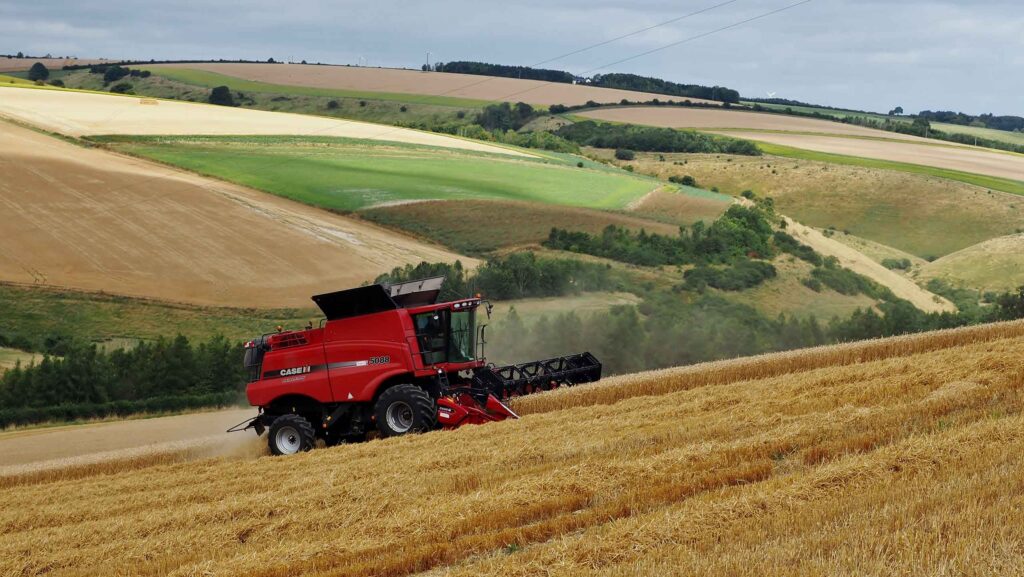Harvest 24: Poor prices add to mixed yield woes
 Cutting wheat near Millington, East Yorkshire (Submitted by Charlotte Precious)
Cutting wheat near Millington, East Yorkshire (Submitted by Charlotte Precious) A spell of better weather has allowed for some farmers to catch up or finish harvest completely, but crops remain a mixed bag, with some pleasant surprises.
See also: Worst harvest for nearly 40 years at Northumberland farm
Wiltshire and Shropshire
It has been a harvest of “chalk and cheese” for Oliver Scott, farm manager at Mawley Hall estates, which comprises 824ha in Wiltshire and Shropshire.
The weather has been more favourable in the latter, with oilseed rape, wheat and barley cuts complete.
The poor autumn drilling is to blame for the conventional oilseed rape yield of 2.95t/ha, compared to an original budget of 3.5t/ha.
The Extase wheat, which averaged 8.34t/ha, was also down from a budgeted 8.5-9t/ha, and has not made the milling spec this year, while winter barley yields were 1t down at 7.06t/ha.
Over in Shropshire, the oilseed rape averaged 3.3t/ha, with a similar oil content of 44%.
Oliver is awaiting the results for the Mascani milling oats, and has just started cutting winter wheat.
“The first few fields look positive at 8-8.5t/ha,” he says. “We are catching the drizzle in Shropshire, which keeps halting plans to cut. In a normal year, we are about 10 days behind the eastern counties, but this year it is definitely longer.”
Norfolk
Across in East Anglia, harvest is complete at Shrubbery Farm near Carleton Rode. Barry Garner finished last week (w/c 12 Aug), with the last 40ha of Dawsum and Typhoon wheat coming in at 9.7t/ha.
“I was absolutely fraught just before harvest,” says Barry. “I thought we would be harvesting popcorn, but I’m happy with the quality, at 13% moisture and 75-79kg/hl specific weight.”
He is equally pleased with the 22ha of Laureate spring barley, which averaged 7.5t/ha.
“The quality is superb,” he adds. “We achieved around 13% moisture, 1.45% nitrogen and no screenings. What is appalling is the price, which is the downside of this year’s harvest.
“I forward-sold some of it a couple of months ago – I just wish I had done more of it. “
Aberdeenshire
Further north, it is a mixed bag of results for Scott Campbell at Kirkton Farm, Kinellar.
After a disappointing start to his oilseed rape harvest, yields fortunately increased from 3t/ha to 3.6t/ha, compared with a five-year average of 4.2t/ha.
The crop was hit by sclerotinia and botrytis as Scott was unable to apply the second mid-spray due to the flowers being blown off.
This, coupled with 1,000mm of rainfall between October and March, has made it a challenging year.
The winter oat crop is looking a lot better, with 28ha averaging 10t/ha at 16% moisture and 56kg/hl.
“However, rising input prices make the process frustrating, because by the time we spend on fertiliser and seed, we either need yields to increase or prices to go up to achieve a better bottom line,” says Scott.
“We need better plant breeds with more disease and fungicide resistance, as we have no control over price.
“We are growing to a high standard, yet imported grain is flooding our markets. It’s a big frustration.”
Spring barley and wheat are now left to cut, but the forecast remains uncertain.
“We have a new crop of Bamford seed that will be ready in a week, which I hope will come in around 11t/ha,” notes Scott. “It has replaced Skyscraper as a soft wheat, and has a £30/t premium over feed.”
County Londonderry
Over in Northern Ireland, a change in soil management has prompted positive outcomes for the harvest at Carse Hall, Londonderry, where Robert Craig has cut and baled his winter barley. It peaked at 8.65t/ha, a 10% increase compared to last year.
He credits a reduction in nitrogen fertiliser, from 206kg/ha to 163kg/ha, and an increase in biostimulant usage as contributing factors to this year’s success.
“For the first time, we applied waste milk across our cereals and grassland, which we mixed with boron and Epsom salts,” he says.
“The soils have responded well and given good yields despite a challenging season. We have seen the benefits of new ideas really come into fruition this year.”
Companion cropping with the oilseed rape has provided a natural slug deterrent, thanks to sunflowers, with additional phosphate from buckwheat and vegetables. Yields averaged 3.95t/ha.
The remaining 40ha of wheat will be cut next week, followed by 16ha of beans at the end of October.
